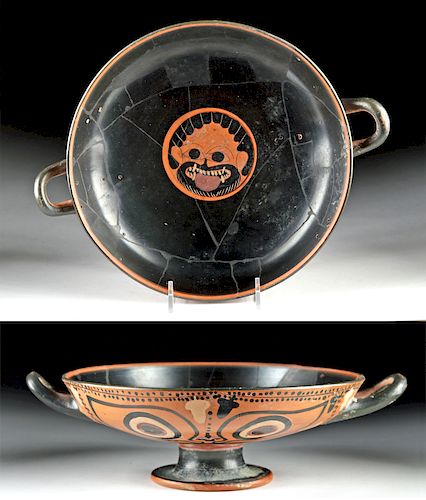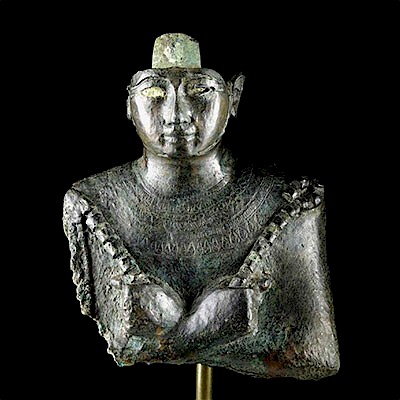Greek Attic Kylix - Eye Cup with Gorgon
Lot 23
About Seller
Artemis Gallery
686 S Taylor Ave, Ste 106
Louisville, CO 80027
United States
Selling antiquities, ancient and ethnographic art online since 1993, Artemis Gallery specializes in Classical Antiquities (Egyptian, Greek, Roman, Near Eastern), Asian, Pre-Columbian, African / Tribal / Oceanographic art. Our extensive inventory includes pottery, stone, metal, wood, glass and textil...Read more
Estimate:
$9,000 - $12,000
Absentee vs Live bid
Two ways to bid:
- Leave a max absentee bid and the platform will bid on your behalf up to your maximum bid during the live auction.
- Bid live during the auction and your bids will be submitted real-time to the auctioneer.
Bid Increments
| Price | Bid Increment |
|---|---|
| $0 | $25 |
| $300 | $50 |
| $1,000 | $100 |
| $2,000 | $250 |
| $5,000 | $500 |
| $10,000 | $1,000 |
| $20,000 | $2,500 |
| $50,000 | $5,000 |
| $100,000 | $10,000 |
| $200,000 | $20,000 |
About Auction
By Artemis Gallery
May 22, 2019
Set Reminder
2019-05-22 10:00:00
2019-05-22 10:00:00
America/New_York
Bidsquare
Bidsquare : Exceptional Day 1: Antiquities Asian Fine Art
https://www.bidsquare.com/auctions/artemis-gallery/exceptional-day-1-antiquities-asian-fine-art-4129
Day 1 of an important 2-day auction featuring exceptional art from around the world - Egyptian, Greek, Etruscan, Roman, Viking, Russian, Near Eastern; Asian Art from China, Japan, Thailand, Vietnam, Burma, India; Fine Art from the 17th century to present. Artemis Gallery info@artemisgallery.com
Day 1 of an important 2-day auction featuring exceptional art from around the world - Egyptian, Greek, Etruscan, Roman, Viking, Russian, Near Eastern; Asian Art from China, Japan, Thailand, Vietnam, Burma, India; Fine Art from the 17th century to present. Artemis Gallery info@artemisgallery.com
- Lot Description
Greece, Athens, ca. 6th to 5th century BCE. A very special kylix cup also called an eye cup as it presents two pairs of wide-open eyeballs painted in silhouette style in black, pink, and red pigments, surrounded by extensive dotted grapevines - the fruit clusters delineated in black and pink. In addition, a magnificent Gorgon face peers out from the tondo - its visage presenting wide open eyes, arched brows, an open mouth revealing teeth and a wagging tongue, and a curly coiffure. Teeth and chin whiskers are delineated in fugitive white pigment, while the tongue is delineated in fugitive red pigment. Scholars believe that Greek vase painters placed eyes on cups, because they were apotropaic - having the power to ward off evil. Another theory is that that when held up to drink, the eye cup would transform into a mask with painted eyes, handles that resembled ears, and the foot resembling a mouth. Size: 10.75" W handlespan x 3.125" H (27.3 cm x 7.9 cm)
The invention of the eye cup is traditionally attributed to Exekias whose eye cup in the Staatliche Antikensammlungen in Munich (530 to 540 BCE) is generally regarded as a masterpiece. Exekias presented large apotropaic eyes and battles between heroes on the exterior and on the interior, Dionysos sailing in a ship with dolphins in the surrounding seas. (https://www.researchgate.net/figure/Attic-black-fi-gure-cup-Munich-Staatliche-Antikensammlungen-2082_fig8_272179770)
Gorgons are frightening beast-like female creatures seen as early as the days of Homer and continued to be used as a monstrous symbol throughout the Roman period. The Gorgon was one of three mythological sisters of the ancient Greek world whose hideous visages embodied the most horrifying aspects of death and the supernatural, with wide open eyes, a pointy protruding nose, a disturbing toothy, fang-framed smile, and a curly coiffure as we see in this example. Known for their potent gazes that could turn one to stone, Gorgons were also favored as architectural ornaments, because it was believed that they would protect those within. Perhaps the most famous image of a Gorgon is featured upon the pediment of the Temple at Corfu (ca. 580 BCE), the oldest known pediment in Greece, preceding this piece by only about forty years.
This piece has been tested using thermoluminescence (TL) analysis and has been found to be ancient and of the period stated. A full report will accompany purchase.
Provenance: private California, USA Collection; ex-Haerr collection, 1970s and 1980s, California, USA
All items legal to buy/sell under U.S. Statute covering cultural patrimony Code 2600, CHAPTER 14, and are guaranteed to be as described or your money back.
A Certificate of Authenticity will accompany all winning bids.
We ship worldwide and handle all shipping in-house for your convenience.
#145790Repaired from multiple pieces with restoration over the break lines. Approximately 10% new clay and some repainting affecting one set of eyes but not the Gorgon or other set of eyes. Nicely done and the form is still lovely. Imagery is vivid as well. Nice iridescence to most of black glazed areas. Several drilled holes from old repairs; these would have had fasteners threaded through them. Tiny TL hole on the base.Condition
- Shipping Info
-
All shipping is handled in-house for your convenience. Your invoice from Artemis Gallery will include shipping calculation instructions. If in doubt, please inquire BEFORE bidding for estimated shipping costs for individual items.
-
- Buyer's Premium



 EUR
EUR CAD
CAD AUD
AUD GBP
GBP MXN
MXN HKD
HKD CNY
CNY MYR
MYR SEK
SEK SGD
SGD CHF
CHF THB
THB
















